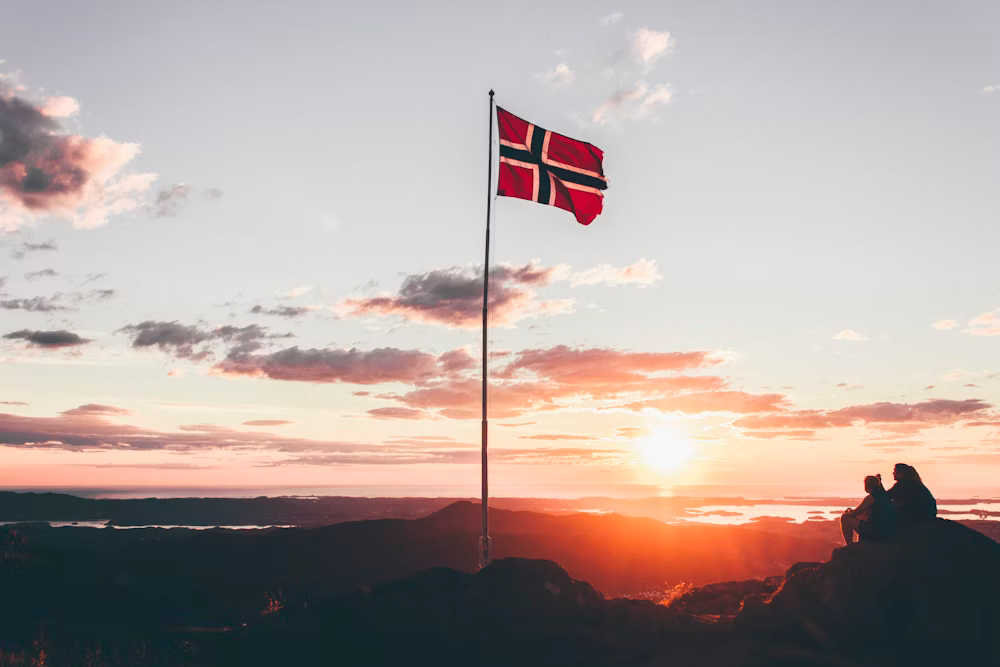The flag of Norway is a striking emblem of the nation’s history, culture, and values. This article delves into the origins, design, and significance of the Norway flag, offering a comprehensive understanding of its role in representing the spirit of Norway.
Historical Background of the Norway Flag
The Norway flag was designed in 1821 by Fredrik Meltzer, a member of the Norwegian parliament. Meltzer’s design aimed to create a distinct national symbol that would inspire pride and unity among Norwegians. The flag’s design was officially adopted, but it was not immediately put into widespread use.
Initially, the Norway flag was not widely flown due to the political union between Norway and Sweden. It wasn’t until 1899, after the dissolution of the union, that the flag began to be flown extensively as a symbol of Norway’s newfound independence. The flag thus became a powerful representation of the nation’s sovereignty and its aspirations for self-governance.
The Design of the Norway Flag
The Colors and Their Meaning
The Norway flag features a deep red field with a dark blue cross outlined in white. These colors—red, white, and blue—are inspired by the flags of other nations that symbolize liberty and independence, such as France, the United Kingdom, and the United States. The choice of colors reflects Norway’s alignment with the ideals of freedom and democracy.
The Cross Symbol
The central feature of the Norway flag is the cross, which extends to the edges of the flag. This cross is a common design element in Scandinavian flags, symbolizing the region’s shared cultural and historical heritage. The cross design is not only a nod to Christianity but also a representation of unity and continuity among the Nordic countries.
Symbolism and Significance
Representation of Liberty and Independence
The colors of the Norway flag—red, white, and blue—are deeply symbolic. They are associated with the principles of liberty and independence, reflecting Norway’s alignment with democratic values. This color scheme links Norway to other nations that have championed these ideals, highlighting a shared commitment to freedom and human rights.
National Identity and Pride
The Norway flag serves as a potent symbol of national identity and pride. It is prominently displayed during national holidays, cultural events, and international competitions. The flag embodies the collective spirit of the Norwegian people and their shared history, culture, and values.
The Flag in Modern Norway
In modern Norway, the flag is an integral part of national celebrations and public life. On Constitution Day, celebrated on May 17th, the flag is flown throughout the country in a vibrant display of national pride. This day commemorates the signing of the Norwegian Constitution in 1814, a pivotal moment in the nation’s history.
The Flag in International Contexts
The Norway flag is also a prominent symbol in international contexts. It is displayed at international sporting events, diplomatic functions, and global gatherings, representing Norway’s presence on the world stage. The flag serves as a reminder of Norway’s commitment to international cooperation, peace, and human rights.
The Design Process and Legislative Adoption
Fredrik Meltzer’s Vision
Fredrik Meltzer, the designer of the Norway flag, envisioned a symbol that would unite the nation and reflect its values. As a member of parliament, Meltzer was acutely aware of the need for a distinct national flag that would inspire a sense of belonging and pride among Norwegians. His design was a thoughtful blend of historical elements and modern symbolism.
Legislative Process
The adoption of the Norway flag involved a legislative process that underscored its significance. Meltzer’s design was presented to the Norwegian parliament, where it was debated and eventually approved. This process ensured that the flag was not only a symbol of national identity but also a product of democratic deliberation and consensus.
The Norway Flag in Art and Culture
Artistic Representations
The Norway flag has been depicted in various forms of art, from paintings and sculptures to modern digital media. Artists have used the flag as a motif to explore themes of national identity, freedom, and cultural heritage. These artistic representations contribute to the flag’s prominence in Norwegian culture and its enduring legacy.
Cultural Celebrations
Cultural celebrations in Norway often feature the flag as a central element. From traditional folk festivals to contemporary music and arts events, the flag is a symbol of national unity and cultural expression. Its presence in these celebrations highlights its role in fostering a sense of community and shared heritage.
The Flag’s Influence on National Unity
A Symbol of Cohesion
The Norway flag plays a crucial role in fostering national cohesion. In times of celebration and crisis, the flag serves as a rallying point for the Norwegian people. It represents a collective identity that transcends regional and political differences, promoting a sense of unity and solidarity.
Educational Significance
The flag is also an important educational tool. Schools in Norway teach students about the history and significance of the flag, instilling a sense of national pride and awareness from a young age. This education helps to ensure that future generations understand and appreciate the flag’s role in their cultural and historical heritage.
The Flag in Norway’s International Relations
Diplomatic Symbolism
In the realm of international relations, the Norway flag is a powerful symbol of the nation’s identity and values. It is flown at Norwegian embassies and consulates around the world, representing Norway’s commitment to diplomacy, peace, and global cooperation. The flag serves as a visual reminder of Norway’s presence and influence on the international stage.
Humanitarian Efforts
Norway is known for its active role in humanitarian efforts and international aid. The Norway flag is often seen in regions affected by conflict or disaster, where Norwegian organizations are providing assistance. This association with humanitarianism enhances the flag’s symbolism as a beacon of hope, compassion, and support for those in need.
The Evolution of the Norway Flag
Historical Changes
While the current design of the Norway flag has remained largely unchanged since its adoption, its history includes various iterations and adaptations. These changes reflect the nation’s evolving political landscape and its journey towards independence and self-determination. Studying these historical changes provides insight into the flag’s significance and its role in Norway’s national narrative.
Future Prospects
Looking ahead, the Norway fla’g is likely to continue evolving as a symbol of national identity and pride. As Norway navigates the challenges and opportunities of the 21st century, the flag will remain a central emblem of the nation’s values and aspirations. Its enduring relevance will be shaped by the ongoing efforts to preserve and celebrate Norway’s cultural and historical heritage.
Conclusion
The Norway fla’g is much more than a mere piece of fabric; it is a profound symbol of the nation’s history, values, and identity. As a symbol of cohesion, the flag unites Norwegians across different regions and backgrounds. It is a central feature in national celebrations, educational curricula, and international diplomacy, representing Norway’s enduring spirit and its contributions to the global community. The Norway fla’g stands as a testament to the nation’s rich cultural heritage and its unwavering commitment to the values that define it.







